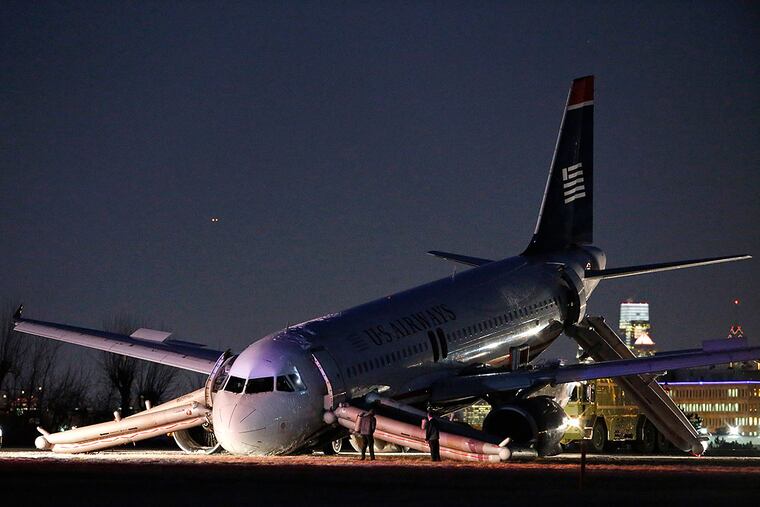MISTAKES MADE
For US Airways Flight 1702 in March 2014, things didn't go well from the start. First Officer Lynda Fleming put the wrong runway - 27R instead of 27L at Philadelphia International Airport - into the flight computer, according to a preliminary investigation by the National Transportation Safety Board.

For US Airways Flight 1702 in March 2014, things didn't go well from the start.
First Officer Lynda Fleming put the wrong runway - 27R instead of 27L at Philadelphia International Airport - into the flight computer, according to a preliminary investigation by the National Transportation Safety Board.
That led to an aborted takeoff for the flight to Fort Lauderdale, Fla., and the collapse of the plane's nose gear. In the end, none of the 149 passengers and five crew was injured. All were evacuated on emergency slides.
The findings, posted recently on the NTSB website, did not identify a cause of the incident. A final report is expected soon.
Runway length is one factor, along with a plane's weight and balance and the temperature, that flight computers use to calculate a plane's proper liftoff speed, known as V1.
Before reaching V1, a pilot can abort because there is enough runway to safely stop. After attaining V1, pilots must take off - except in catastrophic circumstances such as both engines blowing out - then alert the airport tower, and circle back to safely land.
Neither Capt. Dave Powell, who was flying the Airbus A320, nor Fleming initially recognized the runway error. Powell noticed it while taxiing to the runway.
He asked the copilot to correct it, and she did. But Fleming failed to reenter all the takeoff data to calibrate a new V1 speed.
"What did you do?" Powell was recorded as saying after a chime indicated that the throttle was "not set" when he thought it was. "You didn't load. We lost everything," he said, referring to V1.
Still, Powell proceeded with takeoff. The plane accelerated past 100 m.p.h., and performance and acceleration were "spot on," the captain told the NTSB probe.
But soon, a "retard, retard, retard" warning sounded in the cockpit. Powell said he had never heard that warning on takeoff, only on landing, and did not know what it meant.
"We'll get that straight when we get airborne," he told the copilot.
Once the wheels lifted off, Powell said, he "felt like the airplane was totally unsafe to fly" and not responding to his controls.
He told Fleming that they needed to get back on the ground or "the result was going to be 'catastrophic.'"
Investigators in the March 13, 2014, accident found that a "check takeoff data" alert was displayed on the flight monitor.
Fleming said she could not recall getting that alert, but if she had, she said, she would have asked the captain for more time.
It was the fourth flight that day for Powell, 61, and the third for Fleming, 62. Both were experienced pilots, based in Charlotte, N.C. Neither had a previous aviation accident.
Powell told investigators that he took daily drugs to treat high blood pressure and cholesterol, as well as an 81 milligram aspirin.
Two days before, on March 11, Powell underwent a cardiac catheterization for "significant coronary artery disease," investigators said.
He was sedated for the procedure with a "short-acting" benzodiazepine that depressed the central nervous system and Fentanyl, commonly used to treat pain, the NTSB said. The documents did not conclude what role medications might have played, if any.
On the day of the incident, Powell left his home in Fort Lauderdale at 5:15 a.m., and hopped a 6:39 a.m. flight to Charlotte, where he joined Fleming. They flew as pilots to Tampa, Fla., and then to Philadelphia.
When Flight 1702 was aborted about 6:30 p.m., the plane hit the runway twice, striking the tail, and then the nose gear collapsed. Pilots and passengers smelled smoke. The tower confirmed that smoke was coming from the left engine.
After passengers were evacuated, some waited nearly 45 minutes in the cold for buses to take them to the terminal.
215-854-2831
@LoydLinda